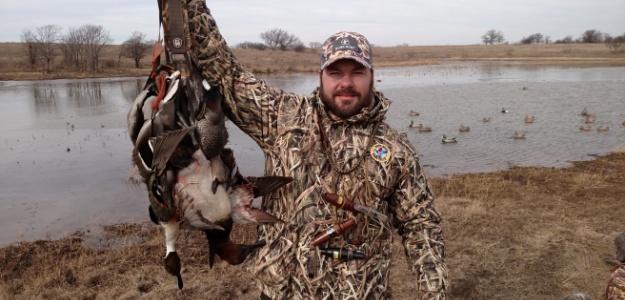J. J. Kent Tells Us about Hunting Texas Ducks

Editor’s Note: J. J. Kent has been a Mossy Oak Pro for 6 years and has what many believe to be a hunter’s dream job. “We can hunt for something every day of the year,” Kent explains. “Here at Kent Outdoors, which I believe to be one of the best hunting destinations in north Texas and southern Oklahoma, we hunt waterfowl, deer, turkeys, hogs, doves and sometimes even crows. My favorite camo to wear is Mossy Oak Original Bottomland, especially when hunting timber, but sometimes I wear Shadow Grass Blades.”
Kent Outdoors has more than 30,000 acres of land that we can hunt here in north Texas and southern Oklahoma. One thing that often surprises many hunters who don’t live in Texas is that we have excellent waterfowl hunting in both places. When most people think about Texas waterfowl, they’re thinking about south Texas near Katy, or along the Red River near the Texas Gulf Coast. However, we’re in the Central Flyway, located about 1/2-hour north of the Dallas/ Fort Worth area. Our property runs from Bonham to Wichita Falls, Tex. We hunt both sides of the Red River and backwaters off the Red River. On its properties, Kent Outdoors homes small acorn ponds, wetlands where we plant millet and other wildlife attractants, cattle ponds, lakes, conservation lakes, flooded wheat fields and milo fields.
We have enough places to hunt ducks that we don’t have to overhunt our ducks. We have conservatively over 200 bodies of water where we can hunt waterfowl. The big advantage to having that much land and that many places ducks hold is not only do we not overhunt a spot, but we can hunt where the ducks are. In the middle of the day, my guides and I go out and scout to learn where the ducks will be for the next morning’s hunt. The following morning we put our hunters on the water where we’ve seen the most ducks concentrated. By having so much property to scout and hunt, we can be where the ducks want to be.
One of the places we hunt is an 8,000-acre cattle ranch with lakes from 5-15 acres each that are used to water the cattle. Around the edges of these ponds are long leaf pond weed, hydrilla and snails in the shallow water. Some of the ponds have acorn trees around them, and the ducks will feed on the acorns. Another advantage to the ponds on this property is that there are wheat fields adjacent to or in close proximity to the ranch. The ducks often will fly into the wheat fields early in the mornings, feed and come back and rest on these ponds in the afternoons. So, besides having plenty of water, we also have an abundance of agriculture for ducks to eat.
In this region, we have good numbers of different types of ducks. We have some bodies of water that will hold large numbers of mallards, while other ponds and lakes will hold pintails, canvasbacks, wigeons, teal, spoonbills, redheads and bluebills. We also have Canada geese, specklebelly (whitefront geese) and snow geese.
Tomorrow: J. J. Kent Tires of Deer Hunting and Learns to Hunt Texas Ducks



























